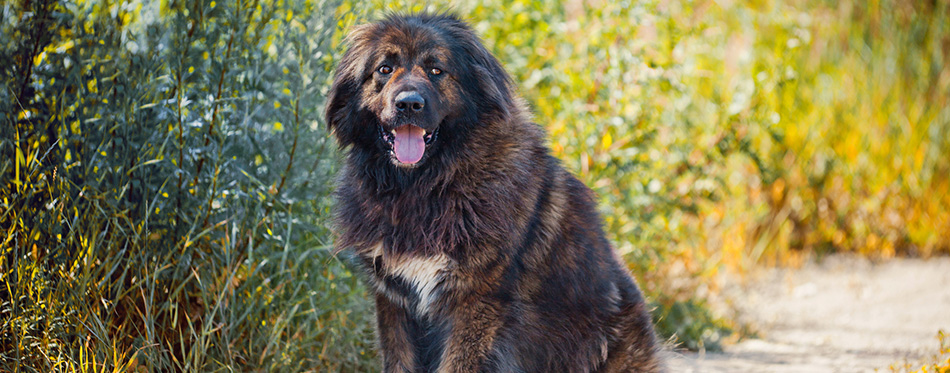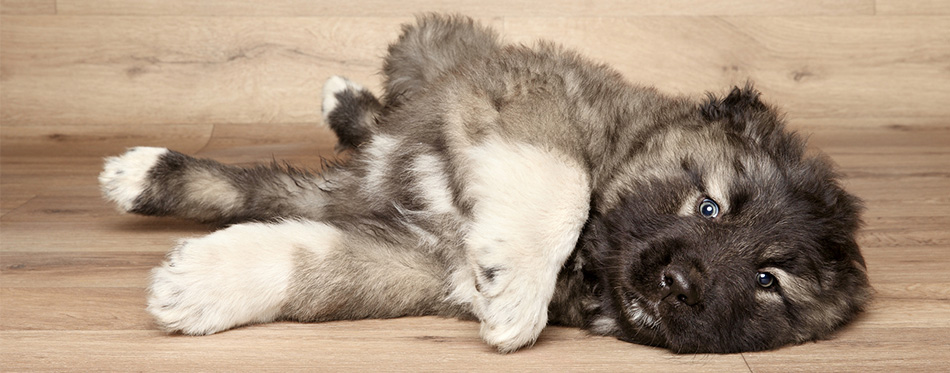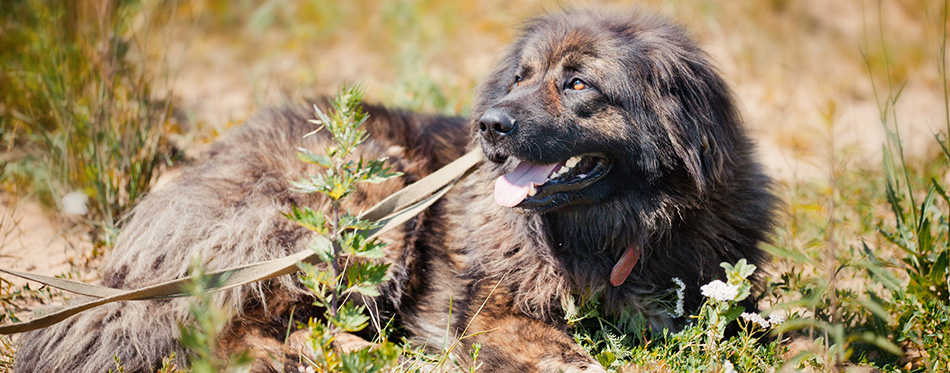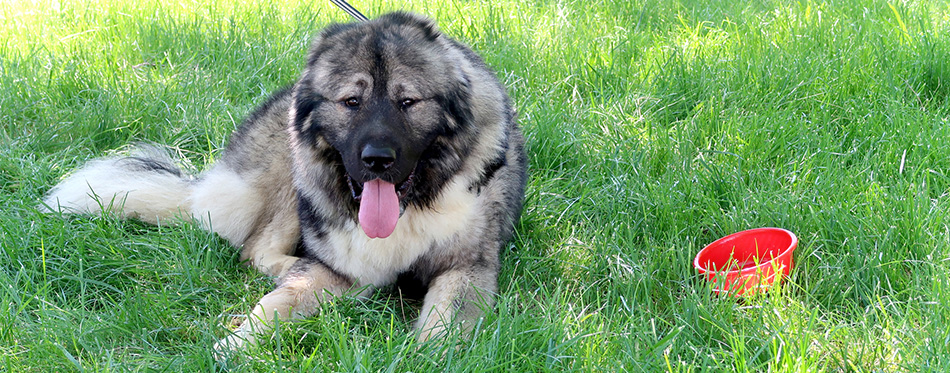If you could turn a Grizzly bear into a pet, now that would be an awesome sight to behold and a truly marvelous feat that’s going to be very difficult to replicate. Well, if you cannot turn a Brown or Grizzly into your own family pet, how about the Russian Bear Dog? It still has the ‘bear’ in its name, although it is 100% a dog. As fluffy and poofy as Manny the Mammoth yet with the fearsome reputation (well, almost) of Diego the Sabertooth and the unquestionable loyalty of Sid the Sloth, the Caucasian Shepherd dog is as controversial as any other species that has the words “Russian” and “bear”. You’d be wrong to think that this colossus of the canine kingdom is as gentle as the St. Bernard. True, its loyalty and affection to its family is unquestionable. Outside this circle, however, you’ll definitely see the Grizzly in this Molosser. Do you think you’ve got what it takes to tame the bear inside this panda-like fuzz ball? Read on.

History of the Russian Bear Dog
Fans of this colossal canine know that the Republic of Georgia is the official origin of the breed. All breed standards are based on the characteristics of Georgian Shepherds. Unfortunately, it was the USSR that registered the breed with the FCI, officially recognizing the breed as having originated in the Russian republic. What many fail to understand is that the USSR of the past is not the same as the Russia of the present.
The Caucasian Shepherd or the Caucasian Mountain Dog is one of the planet’s oldest living breeds that belong to the Molosser type of dogs. They have been in the Caucasus for more than 2,000 years, having descended from the sheepdogs of Mesopotamia.
Because of its massive size and immense strength, the peoples of the Caucasus region used the Caucasian Shepherd in defending their flock against predators especially wolves, bears, and jackals. The Russian Bear Dog is not only a formidable livestock guardian, it can also be that burly henchman or pub bouncer on your door ready to pounce on anything and anyone that it perceives as a threat to you, your family, and your property.
It is this fearsome reputation that many pet parents are having second thoughts about bringing the Russian Bear dog into their homes. There is no question that its loyalty and dedication is to its family. But this also underscores the danger it poses to other people who may be friends with you, but the Caucasian Shepherd may see it the other way.
There are many varieties of Caucasian Shepherds that are distinct to the geographic region where they are raised. Those that thrive in mountainous areas look more massive than their counterparts in the lowlands. Caucasian Mountain Dogs have a more muscular build and possess a heavier, denser coat. Caucasian Shepherds in the lowland regions look taller than their mountain cousins for the simple fact that their built is lighter.
By the 1930s, the Russian Bear Dog was already gracing the Show Rings of Germany. These show dogs were officially called the Caucasian Ovcharka. Its unique physical features, fluffy coat, and a very intimidating presence make the Caucasian Shepherd such a wonder in the Ring. As a matter of fact, it is its inherent uniqueness that makes the breed the most active in terms of participation in a variety of dog shows.
In the 1960s, these massive dogs were used by the East German authorities as border patrol dogs, securing the eastern side of the Berlin Wall. When the Wall collapsed in 1989, more than 7,000 of these behemoths were given to German families and, thus started the introduction of the breed to the rest of the world.
The Caucasian Shepherd Dog is officially recognized by the FCI, AKC, and the UKC. It continues to assist Georgian and Caucasus shepherds in protecting their sheep and other livestock. In other parts of the globe, however, the Caucasian Shepherd is a venerable companion and guard dog. Its gigantic sight alone is enough to stop an intruder or wrong-doer dead on its tracks. This is one giant that thieving Jack can never slay.
Quick Facts
Are you ready to bring home the Caucasian Shepherd? Well, why not take a look at the facts of the breed before make any firm commitments in bringing this massive dog home?
- Male Caucasian Shepherd dogs weigh between 110 and 220 pounds, often depending on the region where they came from. Females of the breed will have a lower weight limit of 100 pounds while maxing out at 180 pounds.
- Caucasian Shepherd dogs from the mountain regions are more muscular while those in the plains are leaner.
- Males can grow up to 30 inches, although the lower limit is about 27 inches. Females, on the other hand can be as tall as 25 to 28 inches with the measurement taken at the level of the shoulders.
- Caucasian Shepherd dogs can come in 3 different lengths of coat – short, medium, and long. Regardless of the length, expect the coat to be extra-thick.
- These dogs have a coarse and longer outer coat plus a soft and fine undercoat.
- Dogs with long hairs typically have very pronounced manes, resembling that of a juvenile lion.
- The color of the coat can be gray, red, solid white, fawn, tan, or cream. In some cases, dogs can sport brindle coats.
- The face of the Caucasian Shepherd always features a ‘dark mask’.
- Because of the thick coat, the Caucasian Shepherd will shed very heavily once a year.

Things You Should Know
No one can question the courage of a Caucasian Shepherd. Its loyalty to its family and the family’s property is so strong that even when threatened by bears and wolves, this mammoth dog will never back down. It is for this reason that the breed is much-sought by individuals who need protection for themselves, their family, and their property. However, just because you need a family and property guard dog doesn’t automatically mean the Caucasian Shepherd is right for you. Continue reading to find out more about this breed and whether or not it is the kind of dog that you can easily handle.
Training
The Caucasian Shepherd is an intelligent breed. Sadly, its stubbornness is a lot stronger than its intelligence especially in the hands of a novice dog owner who simply lacks the skills or even the understanding necessary to be the leader of this dog. As such, only a dog owner who already has an extensive experience working with challenging dogs and who has enough mastery of positive reinforcement techniques can be the rightful pet parent of this mountain of a dog.
Part of the issue is the breed’s natural capacity for independent thinking. It doesn’t like to be told what it needs to do. It already knows that its primary function is to guard you, your family, and your property. Anything outside this scope is almost foreign to it that it treats it with disdain.
However, if you start it from puppyhood, there is a chance that this fiercely loyal yet stubborn dog will still follow your commands. Never employ harsh training methods such as punishments. This breed doesn’t take too kindly to being hurt. It will strike back and you don’t want to be on the receiving end of its monstrous teeth. Follow a training program that teaches your young Caucasian Shepherd that nothing in life is free. If you’re not sure how this works, then get a professional to do it for you.
Feeding
There’s a common misconception that large and giant dogs need more food because of their size. However, giving them more than what their bodies need can also be detrimental to their health. For instance, we are always taught that puppies should be given high-calorie, high-protein, and high-calcium and phosphorus diets. Unfortunately, giving such a diet to a giant breed puppy will only accelerate its growth. That’s good, right? Wrong!
You see, if you put too much calories and too much calcium and phosphorus into a growing giant breed puppy like the Caucasian Shepherd, you are increasing the risk of developmental orthopedic disorders. As such, their diet should always be less calorie-dense, high-protein, and with the correct amounts of calcium and phosphorus. Besides, the Caucasian Shepherd doesn’t really require that much energy since it is more of a modified couch potato than working dog.
It’s always best to consult your vet because he can give you pointers on the exact amount of dog food to feed your young Caucasian Shepherd. It may also be wise to include glucosamine in its diet.
For more guides on choosing the right dog food, you may wish to check out our reviews of the best organic dog food, grain free dog food, puppy food, dehydrated dog food and dog food toppers.
Exercise
The Russian Bear Dog may be uncannily large, but its energy levels are surprisingly low. This doesn’t mean, however, that you can already let it lie down all day long in its oversized doggie bed. On the contrary, you’d still have to take it for a walk on a daily basis. A good walk for this breed usually means an hour or so.
Make sure that if you’re going to take it for a walk, it is fully secured to a leash. Because of its natural distrust of anything and anyone outside its family circle, it may show aggression to other dogs in the neighborhood especially if it wasn’t properly trained and socialized when it was still a puppy.
This breed is best reserved for homes with large, fenced backyards so you don’t have to take it for a walk everyday just to get its exercise. You can create a mini obstacle course right in your backyard to give it something to do. This is important not only physically, but also mentally as well. Remember, this mammoth of a dog is smart. And intelligent dogs get easily bored if the activities they are presented with are simply not stimulating or interesting enough.

Socialization
We’ve been talking about how fiercely loyal the Russian Bear Dog is. Unfortunately, its loyalty is only limited to its immediate family. Strangers or even friends of the family can be met with that fearsome reputation of a massive guard dog with its lion-like features and Grizzly bear-like strength. While you may think that your child is safe in the company of this giant, you’d be wrong. If not properly trained and socialized, this breed can easily snap at your little angel especially the young ones who know nothing about how to properly care for a dog.
These dogs are also not particularly keen on sharing their ‘territory’ with other pets, be it cats or other dogs. They are very territorial, a trait that is deeply ingrained in their sheep guarding duties in the Caucasus mountain ranges. However, there is hope. If you integrate enough socialization while it’s still a puppy, there is still a chance that it can live in relative peaceful coexistence with other pets; although there are no guarantees.
Grooming
Regardless of the length of the coat of the Russian Bear Dog, expect it to be very thick, requiring frequent, regular brushing to help keep it in pristine condition and prevent mats and tangles. If the length of the coat is relatively short, twice or thrice weekly brushing is often enough. However, if it is medium-length or longer, daily brushing is an absolute must; unless you don’t mind having a giant rag doll.
Russian Bear Dogs are known to be heavy shedders. The good news is that they don’t shed heavily all year round. It pays to have a deshedding tool just in case this time arrives.
Don’t forget to brush the dog’s teeth as this can keep cavities and gum problems at bay. It is preferred that daily brushing be done. If this is not possible, then you should strive to brush your Russian Bear Dog’s teeth at least twice a week. As for its nails, clipping it just as soon as you hear clanging or scraping sounds on your floor whenever it walks should be fine; although checking it every now and then is a lot better.
You can also give your giant dog a bath using a dog shampoo. If your mammoth canine cannot fit inside your bathtub, you may want to give it a bath outdoors. However, time it so that the outdoor temperature will be warm. Clean its ears at least once a week; more frequently if it stays outdoors most of the time.
A trip to a dog groomer once every 6 months should give your Russian Bear dog the kind of look that it deserves. However, be especially cautious since your dog groomer is a stranger to the Russian Bear Dog.
For more help on dog grooming, you may wish to read our guides on the best medicated dog shampoos, dry shampoos for dogs, shampoo for puppies, dog drying towels, dog wipes and dog nail clippers.
Health
Hip dysplasia is very common in this dog, just like any other large and giant breed. While glucosamine supplementation will not prevent this from happening, especially since the condition is inherited, it can somehow lessen the impact of such a disorder when your dog has reached its full-grown size. Remember that this dog can weigh more than 200 pounds. Imagine this weight bearing down on its joints.
Another health condition that this breed is known for is cataracts as well as uveitis. These are not preventable, yet they can be easily managed if recognized early on. What your vet can do is to manage these conditions so that the complications can be minimized, if not totally eliminated.
The Caucasian Shepherd is not for everyone. If you happen to be any of the following, then you’ll have a much better chance of being the pet parent of this colossal dog.
- Have worked with dogs before and know exactly what kind of training and socialization this dog needs
- Have access to an open field that is free from other people and other animals
- Commit to at least 1 hour of every day walking on a leash
- Will not use punishment to teach or train the dog
- Doesn’t have other dogs or other pets in the home
- Doesn’t mind pet hair on the couch, carpet, and floor
If you are any of the following, you should look for another dog:
- Novice or newbie dog owner
- Doesn’t know or understand advanced techniques of dog socialization and training
- Uses harsh methods and punishment in training dogs
- Live in an apartment or a house without a large backyard
- A couch potato; not keen on taking a dog for a 1-hour walk
- Have pet dander allergy

Temperament
The Russian Bear Dog may seem lethargic when not given the task it needs. Threaten its family and you’ll instantly see the agility, strength, and speed of a Grizzly bear in this giant hound. No one threatens the Caucasian Shepherd’s family or his property. They are deeply territorial. And if you have other dogs in your home, you don’t want to get a Caucasian Shepherd unless you’re ready to give up your original pet. Its temperament is dependent on how well it was trained and socialized as a puppy. Heed this well and you might as well end up with a giant protector that should love you and your family unconditionally.
While the Caucasian Shepherd is fully capable of unquestionable loyalty, unconditional affection for its family and a fierce protector of everything its family holds dear, it can also be naturally distrustful of anything and anyone it is not familiar with. If you need a dog that will protect ONLY you and your family, the Caucasian Shepherd is a four-legged guardian and protector that you can always count on.
You May Also Like Our Guides On: German Shepherd Rottweiler Mix, Shepradors, Australian Shepherd, Anatolian Shepherd and White German Shepherd.
Sources:
- Caucasian Shepherd Dog – AKC
- The Russian Bear Dog – Guide To The Caucasian Shepherd – Animal Corner

